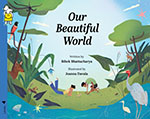A few weeks ago in Himachal Pradesh, this year’s monsoon flooded towns and swelled rivers, causing buildings and bridges to collapse, entire mountain sides to cave in, and cars and concrete structures to be washed away in an angry, muddy, and swollen Beas. It was a harrowing reminder of what we humans do to the land we live on. Sitting in a relatively safe part of the lower mountain ranges, I wondered how more of us aren’t alarmed at the state we are in, when it so clearly is the only world we know, and it is on fire. Year after year we share WhatsApp forwards and watch primetime news tickers of houses crumbling down into concrete and rubble-filled rivers, forest fires raging across hectares of hill sides, coastlines becoming more vulnerable to intense cyclones, Adivasi communities protesting against mining projects that threaten our jal-jangal-zameen. Yet we observe these things as though the crisis is somewhere far off, and as though the health of the world we live in is somehow disconnected from the foundations of our own lives as a species.
Our Beautiful World, written by Bibek Bhattacharya, is an attempt to open a conversation with its readers about how humans have managed to ‘create a monster: climate change’. As a non-fiction picture book, it nudges us to think about the cost of our comforts, of making our lives easier and easier while ‘the world is becoming a desert. Oceans are rising, glaciers are melting, crops are failing. The heat is rising.’ It traces the story of the earth, starting about 12,000 years ago when the ice age retreated, earth’s climate became warmer and stabilized, and the geological epoch Holocene was ushered in. From then on, it follows humans and our relationship to the world around us as agriculture was discovered, civilizations flourished, trade grew, land use changed and with it the industrial age began. Written in the form of a chronological narrative, Our Beautiful World tries to put in very real terms what climate crises mean for the future of the world we know, ‘when cities like Mumbai and Kolkata might be deserted and the sea levels will rise, when glaciers will melt faster and heatwaves will make forests burn every year, wildlife will starve and drinking water will be hard to get by, pandemics and epidemics like COVID-19 will become more common’ and so on.
The last few pages of this book focus on the possibility of hope, suggesting that if the whole world stopped burning fossil-fuels and if our ways of drawing energy could increasingly be sun, wind and water-based, we can defeat the ‘climate change monster’. In an as yet small but significant section of children’s literature talking about various facets of the climate emergency we live amidst, this book is a notable addition. As a non-fiction resource that spells out the history of the climate crisis and tracks how we reached this stage viz., our relationship to earth, it would be a comfortable and engaging read for independent readers. The illustrations by Joanna Davala are intricate and delightful, the pages are littered with human and non-human subjects in play with each other. The use of abstract symbols and non-linear representations in an otherwise chronologically linear text make for an interesting design and layout of the book and I am sure young readers will feel involved in each page’s visual narratives.
The effort of writing in deep and engaging ways about the climate crisis for young readers from all walks of life is admirable; however to me this book falls short in its understanding of what can be done about the climate crisis. It doesn’t acknowledge the geopolitics the environmental movement is situated within. In promising the defeat of climate change ‘if every country around the world says NO to fossil fuels’ and stopping there, it is limited in its understanding of the state’s role in capitalist resource consolidation and the flagrant violations of and changes to environmental laws and policies we are witnessing all around us. Many of our textbooks, too, while starting conversations on environmental crises evade talking about their interconnections with the structural systems of capitalism, caste, patriarchy, sexuality, ableism, imperialism and more. Talking about climate change and environmental destruction can’t be removed from virulent poverty, ever-widening inequality, its impact on displaced, marginalized communities and already endangered species, and neo-liberal and profit-making agendas.
Perhaps Our Beautiful World has been written with the aim of not wanting to heap younger readers with too much information. If so, there is also a case to be made for treating our readers as equals, and as thinking beings who don’t need over-simplified content at the cost of cutting out portions of the picture. The readers will engage with the book and its questions and ideas in their own ways, and so it would have been valuable to see some questions, little nudges or resources, links for readers to explore to see the insidiousness of climate change in all our lives. Inviting readers to examine the climate emergency’s relationships to our different social, economic, political, historical, and cultural worlds would have also allowed for more contextual grounding. As with Our Beautiful World, Pratham Books’ consistent attempts to engage with the climate emergency through a variety of narrative-forms is urgently needed and commendable. Pratham Books’ commitment to making books available in multiple languages and in print as well as digital forms makes these stories even more accessible. I hope that going forward one sees a transition from books exclusively imparting knowledge and raising awareness about the climate crisis to also building skills for critical reflection, and helping readers rethink ideas of well-being, resilience, and our relationships to the world we live in.
November 2023, volume 47, No 11

